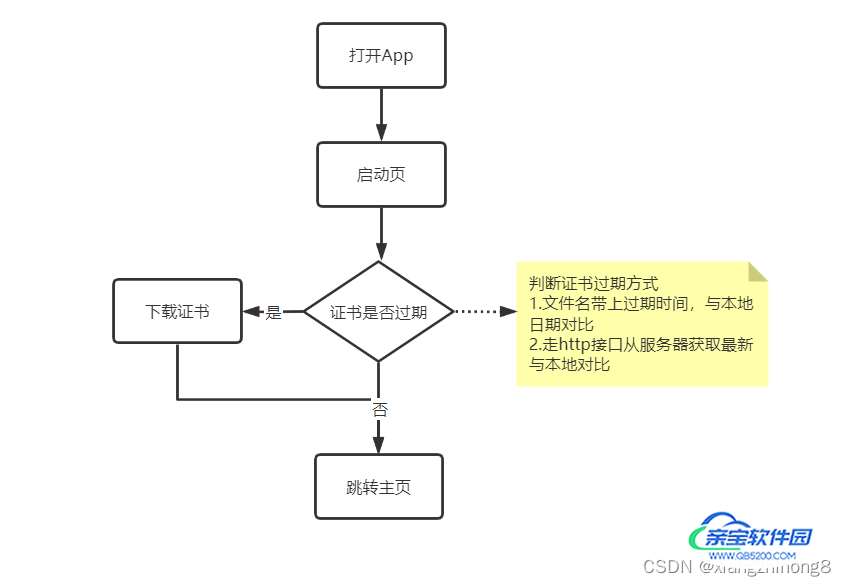Android Https证书过期的两种解决方案
xiangzhihong8 人气:0应该有很多小伙伴遇到这样一个问题,在线上已发布的app里,关于https的cer证书过期,从而导致app所有网络请求失效无法使用。
这个时候有人就要说了,应急发布一个已更新最新cer证书的apk不就完事了么,其实没那么简单,iOS还好可以通过appstore提供的api查询到新版本,但android就不一样了,需要调用自己Server端提供的api接口查询到新版本,并获取apk下载路径,问题是https都不能访问了,如何请求到版本信息呢?下面提供两种常见的解决方案:
方案一
将版本信息接口让后台改成http(不推荐,后台因素不可控),或者将本地https的设置一个不安全校验(推荐)。
private static OkHttpClient newOkHttpClient(int timeout){
HttpLoggingInterceptor logging = new HttpLoggingInterceptor();
logging.setLevel(HttpLoggingInterceptor.Level.BODY);
return new OkHttpClient.Builder()
.addInterceptor(new RequestInfoInterceptor())
//.addInterceptor(logging)
.addNetworkInterceptor(new TokenHeaderInterceptor())
.sslSocketFactory(Certificate.getSSLSocketFactory())
//设置不安全校验
.hostnameVerifier(Certificate.getUnSafeHostnameVerifier())
.readTimeout(timeout, TimeUnit.SECONDS)
.writeTimeout(timeout, TimeUnit.SECONDS)
.build();
}
/**
*获取HostnameVerifier
*/
public static HostnameVerifier getUnSafeHostnameVerifier() {
HostnameVerifier hostnameVerifier = new HostnameVerifier() {
@Override
public boolean verify(String s, SSLSession sslSession) {
return true;
}
};
return hostnameVerifier;
}方案二
将xxx.cer证书改成动态读取(以文件的方式从app沙盒里面读取即可),在https证书即将过期时,从服务器下载最新的cer证书更新到沙盒里面,App每次初始化网络请求时读取sdcard最新的证书文件,这样App就永远不会出现https证书过期导致无法使用的问题,流程图如下。

下面是一些关键的代码:
private static OkHttpClient newOkHttpClient(int timeout){
HttpLoggingInterceptor logging = new HttpLoggingInterceptor();
logging.setLevel(HttpLoggingInterceptor.Level.BODY);
return new OkHttpClient.Builder()
.addInterceptor(new RequestInfoInterceptor())
//.addInterceptor(logging)
.addNetworkInterceptor(new TokenHeaderInterceptor())
.sslSocketFactory(Certificate.getSSLSocketFactory(BaseApplcation.myApp, new String[]{"/sdcard/xxx.cer"}))
.hostnameVerifier(Certificate.getUnSafeHostnameVerifier())
.readTimeout(timeout, TimeUnit.SECONDS)
.writeTimeout(timeout, TimeUnit.SECONDS)
.build();
}
/**
* 带证书的,从本地文件读取
* @param context
* @param certificatesFiles 本地文件(通过下载到本地)
* @return
*/
public static SSLSocketFactory getSSLSocketFactory(Context context, String[] certificatesFiles) {
if (context == null) {
throw new NullPointerException("context == null");
}
CertificateFactory certificateFactory;
try {
certificateFactory = CertificateFactory.getInstance("X.509");
KeyStore keyStore = KeyStore.getInstance(KeyStore.getDefaultType());
keyStore.load(null, null);
for (int i = 0; i < certificatesFiles.length; i++) {
InputStream certificate = new FileInputStream(certificatesFiles[i]);
keyStore.setCertificateEntry(String.valueOf(i), certificateFactory.generateCertificate(certificate));
if (certificate != null) {
certificate.close();
}
}
SSLContext sslContext = SSLContext.getInstance("TLS");
TrustManagerFactory trustManagerFactory = TrustManagerFactory.getInstance(TrustManagerFactory.getDefaultAlgorithm());
trustManagerFactory.init(keyStore);
sslContext.init(null, trustManagerFactory.getTrustManagers(), new SecureRandom());
return sslContext.getSocketFactory();
} catch (Exception e) {
}
return null;
}
/**
* 带证书的,从raw资源中读取
* @param context
* @param certificates rawIds
* @return
*/
public static SSLSocketFactory getSSLSocketFactory(Context context, int[] certificates) {
if (context == null) {
throw new NullPointerException("context == null");
}
CertificateFactory certificateFactory;
try {
certificateFactory = CertificateFactory.getInstance("X.509");
KeyStore keyStore = KeyStore.getInstance(KeyStore.getDefaultType());
keyStore.load(null, null);
for (int i = 0; i < certificates.length; i++) {
InputStream certificate = context.getResources().openRawResource(certificates[i]);
keyStore.setCertificateEntry(String.valueOf(i), certificateFactory.generateCertificate(certificate));
if (certificate != null) {
certificate.close();
}
}
SSLContext sslContext = SSLContext.getInstance("TLS");
TrustManagerFactory trustManagerFactory = TrustManagerFactory.getInstance(TrustManagerFactory.getDefaultAlgorithm());
trustManagerFactory.init(keyStore);
sslContext.init(null, trustManagerFactory.getTrustManagers(), new SecureRandom());
return sslContext.getSocketFactory();
} catch (Exception e) {
}
return null;
}加载全部内容